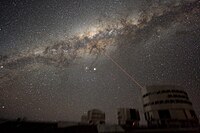
The Fermi-LAT GeV excess as a tracer of stellar mass in the Galactic bulge
Sign Up to like & getrecommendations! Published in 2018 at "Nature Astronomy"
DOI: 10.1038/s41550-018-0531-z
Abstract: An anomalous emission component at energies of a few gigaelectronvolts and located towards the inner Galaxy is present in the Fermi-LAT data. At present, the two most promising explanations are the annihilation of dark matter… read more here.
Keywords: bulge; stellar mass; dark matter; fermi lat ... See more keywords

A complete sample of LSP blazars fully described in γ-rays: New γ-ray detections and associations with Fermi-LAT
Sign Up to like & getrecommendations! Published in 2018 at "Astronomy and Astrophysics"
DOI: 10.1051/0004-6361/201832786
Abstract: We study the $\gamma$-ray and broadband spectral energy distribution (SED) properties of a complete sample of 104 bright, radio-selected low-synchrotron peaked (LSP) blazars. Most of the sources have already been detected in the $\gamma$-ray band… read more here.
Keywords: gamma ray; detections associations; fermi lat; complete sample ... See more keywords

Detection of virial shocks in stacked Fermi-LAT galaxy clusters
Sign Up to like & getrecommendations! Published in 2018 at "Journal of Cosmology and Astroparticle Physics"
DOI: 10.1088/1475-7516/2018/10/010
Abstract: In the hierarchical paradigm of structure formation, galaxy clusters are the largest objects ever to virialize. They are thought to grow by accreting mass through large scale, strong virial shocks. Such a collisionless shock is… read more here.
Keywords: gamma ray; detection virial; fermi lat; virial shocks ... See more keywords

Search for semi-annihilating dark matter with Fermi-LAT, H.E.S.S., Planck, and the Cherenkov Telescope Array
Sign Up to like & getrecommendations! Published in 2019 at "Journal of Cosmology and Astroparticle Physics"
DOI: 10.1088/1475-7516/2019/04/048
Abstract: Dark matter annihilations have been fiercely restricted by the non-observation of excess events in indirect detection probes. Typically the interactions that dictate annihilation are also present in the dark matter-nucleon scattering cross section, also severely… read more here.
Keywords: telescope array; cherenkov telescope; matter; dark matter ... See more keywords

Analysis of Fermi-LAT observations, UHECRs and neutrinos from the radio galaxy Centaurus B
Sign Up to like & getrecommendations! Published in 2019 at "Journal of Cosmology and Astroparticle Physics"
DOI: 10.1088/1475-7516/2019/08/023
Abstract: Centaurus B (Cen B) is one of the closest and brightest radio-loud galaxy in the southern sky. This radio galaxy, proposed as a plausible candidate for accelerating ultra-high-energy cosmic rays (UHECRs), is near the highest-energy… read more here.
Keywords: energy; radio; analysis; fermi lat ... See more keywords

Analysis of Fermi-LAT data from Tucana-II: possible constraints on the Dark Matter models with an intriguing hint of a signal
Sign Up to like & getrecommendations! Published in 2019 at "Journal of Cosmology and Astroparticle Physics"
DOI: 10.1088/1475-7516/2019/08/028
Abstract: Tucana-II (Tuc-II), a recently discovered and confirmed Ultra Faint Dwarf Spheroidal galaxy, has a high mass to light ratio as well as a large line-of-sight stellar velocity dispersion, thus making it an ideal candidate for… read more here.
Keywords: matter; dark matter; fermi lat; analysis fermi ... See more keywords

Fermi/LAT observations of lobe-dominant radio galaxy 3C 207 and possible radiation region of γ-rays
Sign Up to like & getrecommendations! Published in 2018 at "Research in Astronomy and Astrophysics"
DOI: 10.1088/1674-4527/18/6/70
Abstract: 3C 207 is a lobe-dominant radio galaxy with one sided jet and the bright knots in kpc-Mpc scale were resolved in the radio, optical and X-ray bands. It was confirmed as a gamma-ray emitter with… read more here.
Keywords: gamma ray; radio; lobe dominant; fermi lat ... See more keywords

Fermi/LAT detection of a transient gamma-ray flare in the vicinity of the binary star DG CVn
Sign Up to like & getrecommendations! Published in 2017 at "Monthly Notices of the Royal Astronomical Society"
DOI: 10.1093/mnras/stx396
Abstract: Solar flares are regularly detected by the Large Area Telescope (LAT) on board the Fermi satellite, however no γ-ray emission from other stellar eruptions has ever been captured. The Swift detection in 2014 April of… read more here.
Keywords: ray flare; fermi lat; cvn; binary star ... See more keywords

Simultaneous long-term monitoring of LS I +61°303 by OVRO and Fermi-LAT
Sign Up to like & getrecommendations! Published in 2018 at "Monthly Notices of the Royal Astronomical Society"
DOI: 10.1093/mnras/sty1037
Abstract: Previous long-term monitorings of the gamma-ray-loud X-ray binary LS I +61{\deg}303 have revealed the presence of a long-term modulation of ~4.5 years. After nine years of simultaneous monitoring of LS I +61{\deg}303 by the Owens… read more here.
Keywords: gamma ray; term; long term; radio ... See more keywords

Searching for the possible signal of the photon-axionlike particle oscillation in the combined GeV and TeV spectra of supernova remnants
Sign Up to like & getrecommendations! Published in 2019 at "Physical Review D"
DOI: 10.1103/physrevd.100.123004
Abstract: The conversion between photons and axionlike particles (ALPs) in the Milky Way magnetic field could result in the detectable oscillation phenomena in $\ensuremath{\gamma}$-ray spectra of Galactic sources. In this work, the GeV (Fermi-LAT) and TeV… read more here.
Keywords: tev; oscillation; supernova remnants; fermi lat ... See more keywords

Investigating the detection of dark matter subhalos as extended sources with Fermi -LAT
Sign Up to like & getrecommendations! Published in 2020 at "Physical Review D"
DOI: 10.1103/physrevd.102.103010
Abstract: Cold dark matter (DM) models for structure formation predict that DM subhalos are present in the Galaxy. In the standard paradigm of DM as weakly interacting massive particle, subhalos are expected to shine in gamma… read more here.
Keywords: investigating detection; fermi lat; dark matter; subhalos ... See more keywords